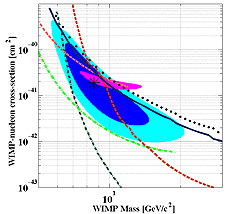Dark-matter search results from CDMS II silicon detectors
 |
| Experimental upper limits (90 percent confidence level) for the WIMP-nucleon spin-independent cross section as a function of WIMP mass. The black dotted line is from the present analysis, and the blue solid line includes previous CDMS II silicon-detector data. Also shown are limits from the CDMS II germanium-detector standard and low-threshold analyses (dark and light dashed red), as well as limits from the XENON collaboration (dark and light dash-dotted green). The magenta oval shows a possible WIMP signal region proposed to explain data from CoGeNT. The light and dark blue regions indicate the 68 percent and 90 percent contours obtained if the present result were to be interpreted as a WIMP signal. The asterisk shows the maximum likelihood point under this interpretation. |
Scientists around the world are working to understand the nature of dark matter, which accounts for most of the mass of the universe. The earth seems to be moving through a cloud of dark-matter particles that encompasses the visible parts of our galaxy. We should be able to sense this dark matter if we can deploy detectors that are sensitive to the 'billiard ball' scatter of a dark matter particle from an atomic nucleus inside these detectors.
The Cryogenic Dark Matter Search (CDMS) experiment was designed to do exactly that, using germanium and silicon detectors cooled to very low temperatures in order to detect the electric charge and heat liberated by single dark-matter particle collisions with nuclei and distinguish them from the messier interactions created by normal matter.
At the American Physical Society April meeting in Denver, the CDMS collaboration presented on Saturday its blind-analysis results from data taken with silicon detectors during CDMS II operation at the Soudan Underground Laboratory. Kevin McCarthy, a graduate student from MIT, presented the results, which were submitted to Physical Review Letters.
The blind analysis resulted in three candidate events. Although this number is higher than the expected background of roughly half an event, this is far from a discovery. Simulations of the known backgrounds indicate that a statistical fluctuation could produce three or more events about 5 percent of the time. In other words, if the experiment were done 100 times, five of them would show at least three events in the signal region even if dark-matter particles did not exist.
However, there is more information on the characteristics of the expected background events and the expected signals from weakly interacting massive particles, or WIMPs, which are the favorite particle explanation for dark matter. A likelihood analysis that includes the measured recoil energies of the three events yields a 0.19 percent probability for the background-only hypothesis when tested against a model that includes a WIMP contribution. This translates into roughly a 3-sigma confidence level for the hypothesis that the three events are due to WIMP interactions. This is exciting but still does not meet the scientific standard for a discovery. Further investigations are necessary.
Nevertheless, if one indulges in a "what if" scenario and interprets the result as due to a WIMP signal, the WIMP mass would be around 8.5 times the mass of a proton. For the simplest theories of WIMP interactions and using the Standard Model for dark-matter distribution in our galaxy, the rate found for such interactions is in some conflict with the current results from the XENON experiments. The paper presents more details.
In 2010, the CDMS collaboration published results on dark-matter searches with germanium detectors, which resulted in two events in the signal region and an estimated background of 0.8 events. The conclusion at the time was that these events were likely leakage surface electrons rather than true nuclear recoils, and other experiments have not found any signals in this mass region.
The SuperCDMS Soudan experiment is currently taking data with larger, and better, germanium detectors, and hopes to shed additional light on low-mass WIMPs before the end of the year. The collaboration is considering the use of silicon detectors in future experiments.
—Dan Bauer
|